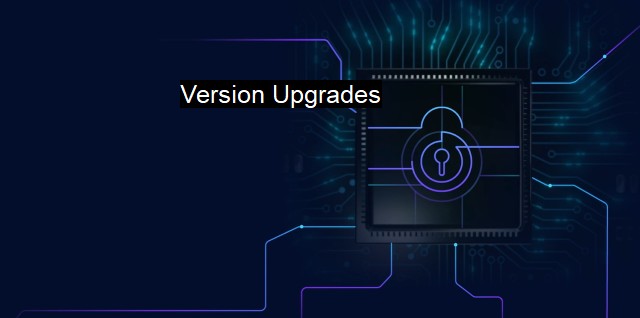What are Version Upgrades?
Importance of version upgrades in cybersecurity: Enhancing Performance, Addressing Vulnerabilities, and Protecting Against Emerging Threats
Version upgrades refer to a process where software or hardware is updated, ensuring an improvement in security and overall operations. They involve replacing an older version of software or hardware components with a newer release, characterized by better security measures, and more refined machine learning algorithms. In the realm of cybersecurity and antivirus software, version upgrades are essential as they help secure network components and prevent malicious activities.Software developers constantly test and improve their applications to fix flaws, increase functionality, introduce new features, improve user-interface, automate processes, and enhance security levels. Once these changes have been finalized they release a new, upgraded version of the software product that existing customers can download and deploy. Subsequently, version upgrades come with the purpose to enhance and protect the software from hacking vulnerabilities or potential cybersecurity threats.
It's essential for users to know that malware and cyber-attacks are becoming more powerful and complicated every day. A software solution that offers optimum protection today might be outdated tomorrow given the dynamically advancing cyber threat landscape. Hence, version upgrades counter this menace by continuously equipping the software with newer techniques to identify and eliminate threats.
A virus is a malicious software program that seeks to exploit any weaknesses in a computer's software. Antivirus programs are purposely designed to detect and eliminate any form of malware. cyber threats are potentially growing and changing with time, necessitating the need for antivirus programs to remain responsive to emerging threats. Version upgrades become instrumental in synthesizing new data into the antivirus software, largely contributing to its capacity to enhance the identification, prediction, and targeted elimination of threats.
Cybersecurity version upgrades are also highly dependent on real-world information. They analyze patterns in identified malware and incursion attempts to understand future attack scenarios better. Upgrades incorporate these changes by tweaking the security algorithms, configuring firewalls to close down incidental backdoors, and creating machine learning patterns that improve the identification of newer threats. As such, neglecting upgrades can lead to situations where an application has become obsolete without the user even realizing it.
A significant factor to consider includes zero-day attacks. These attacks occur on the same day a weakness is discovered in a software application before the developers have released an update, or a 'patch' to rectify it. Robust and sophisticated cyber attackers reverse-engineer patches to identify vulnerabilities. Living in the constant fear of such attacks and understanding that it is not always possible for a software to respond to an upgrade on the same day attacks happen, upgraded versions come released beforehand, ready to deploy a defense mechanism when attacks like these take place spontaneously.
Therefore, businesses, organizations, governments, and individual end-users require version upgrades for improved cybersecurity. The older the version of software or hardware an entity is using, the more susceptible it becomes to hackers who have learned and evolved away from that technology, continuously seeking loopholes in it.
Version upgrades also tend to trim down any inefficiencies built into the previous variant, practically making programs run smoother and faster with less demand on system resources. This has the added benefit of quicker system scan times with less likelihood of performance issues.
Version upgrades signify much more than a mere tool for marketers to persuade consumers into spending extra. They serve as an adaptive response to an ever-changing world of increasing cyber threats, providing comprehensive coverage, protecting users' vital information.

Version Upgrades FAQs
What is a version upgrade in antivirus software?
A version upgrade in antivirus software often refers to the release of a newer and more advanced version of the software, which includes new features, improvements, and bug fixes. It is essential to upgrade your antivirus software to the latest version to ensure maximum security against cybersecurity threats.How can version upgrades help in enhancing cybersecurity?
Version upgrades can help enhance cybersecurity by providing new and advanced features that can detect and prevent cyber threats more effectively. These upgrades can also fix any vulnerabilities or bugs in the previous versions, making the software more robust and secure.Is it necessary to pay for version upgrades in antivirus software?
Whether you need to pay for version upgrades in antivirus software depends on the vendor's policy. Some vendors offer free upgrades for their users, while others charge a fee for every upgrade. However, paying for version upgrades can ensure that you receive the latest and most advanced features, protecting your system from the latest cyber threats effectively.How can I upgrade to the latest version of my antivirus software?
To upgrade to the latest version of your antivirus software, you can check the vendor's website for the upgrade process. Typically, you can download the latest version from the vendor's website and install it on your system. You may need to uninstall the previous version before installing the latest version. Some antivirus software may also offer an automatic upgrade option, notifying you when a new version is available.| | A | | | B | | | C | | | D | | | E | | | F | | | G | | | H | | | I | | | J | | | K | | | L | | | M | |
| | N | | | O | | | P | | | Q | | | R | | | S | | | T | | | U | | | V | | | W | | | X | | | Y | | | Z | |
| | 1 | | | 2 | | | 3 | | | 4 | | | 7 | | | 8 | | |||||||